If you’ve been following my postings, you know that I am Miss Shirley and I am a chubby cat. If you missed the first installment of my weight loss adventure, read it here! 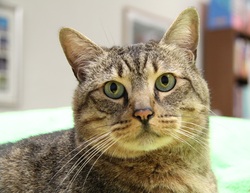 I'm trying to remain positive! When I first got to my foster home, my fur was greasy. I wasn’t really taking care of it. The Shelter cage was so small and it was hard to turn around in it—I am a big girl, you know. And I really wasn’t in the mood. I missed my family. I missed my chair.
My foster mom ignored my dirty fur for a while. I guess she was hoping I would get to it once I was out of cage. I cleaned my front paws nicely, but I couldn’t twist very well to get the rest of me. That’s because I’m fat.
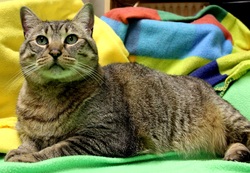 Not quite ready for bikini season So what happened? I got a bath!! So degrading! I was a good kitty, I didn’t show my claws. I did talk a lot. A lot. And it kinda felt good. And it made it easier to clean myself. I’m mean there wasn’t so much work. All I had to do was straighten everything. Still I couldn’t quite reach all of me. I’m thinking I will be able to when I become a thin kitty again.
Once I started cleaning my tummy regularly my bowels started to move more frequently. They were still kinda tough, but with less inside I was more comfortable and more mobile. Climbing the cat tree wasn’t so hard.
Well, the first week of December was a big week for me. I really wanted to show off how well I was doing on my diet. We went to Pinnacle Animal Hospital and Dr. Forgy greeted me like an old friend.
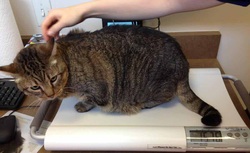 Pictures were taken to show my progress. I just knew I was doing well. Dr. Forgy said I wasn’t dehydrated so I wasn’t to worry about my bowels. As I got more active things would move better. Easy for her to say. She gave me some hope. Then I got weighed. I’d lost only 0.2 pounds. That’s just over 3 ounces! I was so disappointed. Dr. Forgy said, “That’s OK! It’s just going to take longer.” Longer! I was looking forward to going back to my old life of open feeding and lounging all day. How was I going to find a forever home if I didn’t show that I could lose weight? Was I doomed to live in a rescue house forever? Want a companion to lose weight with? Adopt Shirley!
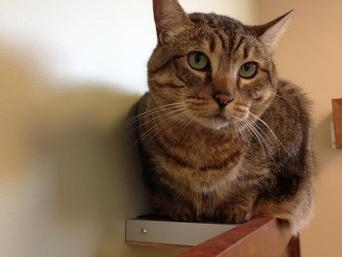 Ignore my muffin tops please Happy New Year Everyone!
I’m Miss Shirley and I am a chubby kitty. This is the story of my search for my thin kitty within. I am hoping to find my permanent home and my forever diet buddy, too.
Once upon a time, I was a normal-sized kitty. I’m not a piggy. Sometimes I leave a little food in my bowl. But I do like to lounge. I guess that was my downfall—no exercise.
When my family surrendered me to the shelter they were warned that some kitties don’t qualify for re-homing. I guess we were in denial of what could happen to me. The shelter staff told me I was too fat for their adoption program—even though I was a very friendly girl. If I didn’t find a rescue group, I would be “put to sleep.” I knew what that meant. Gulp!
So I talked to every worker and every volunteer. I greeted them with a chirp and nuzzled against the cage seductively. “Rub my head. Scratch my ears.” I have a very deep and gravelly voice and I tried to sound as sweet as I could. Some people say I sound like Lauren Bacall or Demi Moore. I say, “Who are they?”
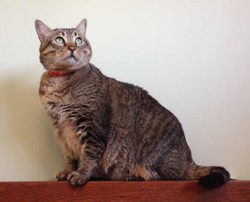 I'm just big boned My strategy worked! The St. Francis Rescue people took me to a foster home that San Jose Animal Advocates found. They arranged for my enrollment at Club Chub! Pinnacle Animal Hospital in San Jose has specialists in weight reduction and I met my doctor. Doctor Forgy was going to help me get thin so I could find a forever home! I learned that she donated her services to me because I was a rescue girl. I thought it was because of all the talking I did when we met.
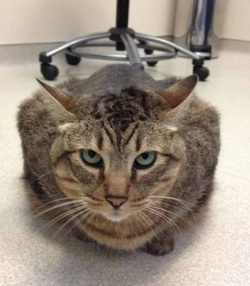 Going on a diet sucks! First, she checked my blood work. All my enzymes and electrolytes were good. Even more important—my glucose level was good. I’m not diabetic or pre-diabetic! Hooray! That improves my chances of weight loss success AND it improves the chance that I will find my forever home.
Next, she weighed me. I weighed 15.5 pounds. On my frame, that’s fat. I’m about 30% overweight and that’s morbidly obese. She took photos. No hiding the truth anymore.
Then, I was given my diet. Hill’s metabolic diet. M/D. Only ¼ cup, two times per day. The local distributor for Hill’s knew I was a rescue kitty and donated my food!
That was last November. Check back here to read more of my story.
This blog post has been contributed by Karen Zamel, SJAA Volunteer 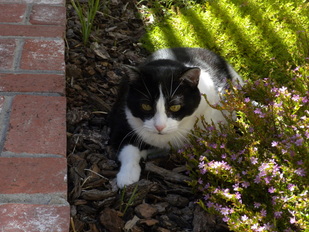 Karen's 15 year old "Mopps" As cats age, their health and wellness needs change – just like with adults. We have four cats at home, and three of them are “geriatric” – ages 13, 14 and 15. As with most pet owners, we want to keep them healthy and happy as long as possible. Our vet, Dr. Jane Johnson of Adobe Animal Hospital in Los Altos, has helped us learn about and address issues that occur for our aging family felines, and has been generous enough to share some of her important insights here.
Dr. Johnson has been part of the Adobe team since 1985 – first as a tech, and then as a vet. She has a degree in chemistry from Princeton, and a degree in Veterinary Medicine from UC Davis.
Many thanks to Dr. Johnson for these answers to our questions...
 15 year old Bosco 1. At what age are cats considered "senior"?
Cats, especially indoor cats, can live over 20 years. They are considered "senior" starting at about 13 or 14 years old.
2. As pet owners, what should we watch for as our cats age?
The main things to watch for are changes – in appetite, drinking, weight, activity level, appearance, elimination habits, breathing – or the appearance of any symptoms such as coughing, sneezing, vomiting, diarrhea.
3. Are there differences in well care as our cats become older – for example, the frequency or type of vet visits?
In the older cat, we usually recommend coming in every 6 months instead of yearly, and we often will do blood tests, radiographs or other diagnostic procedures, especially if any of the above symptoms are present.
4. Dental issues are always a concern in senior cats...what kind of tooth and gum care do senior cats need?
Dental care should start at a young age, ideally with brushing the cat's teeth at least a few times weekly. In any case, the teeth and gums should be evaluated at each veterinary visit, and they should definitely be checked if you notice redness, bleeding, bad breath or masses in the mouth. Often times, the teeth need to be cleaned to eliminate plaque and the bacteria that can cause problems in the entire body. We do not recommend the anesthesia-free teeth cleaning, as these procedures do not address any decay or infection that may be occurring under the gums, and they can often lead to broken teeth and retained, infected roots.
5. What should we be alert about as our cats age? Are there changes that are okay, vs. changes we should be concerned about?
As in #2 above, most of the changes that you see in your older cat should at least be evaluated to make sure that they are part of natural aging, rather than part of a disease process. In older cats, probably the number one indication for seeing your vet would be the cat starting to drink more water – as cats age, they are prone to developing kidney disease, hyperthyroidism, or diabetes, and drinking extra water can be the first symptom of these problems.
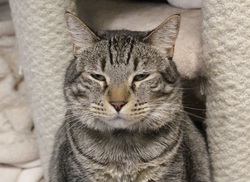 Hamilton is available at the San Jose shelter Consider Adopting a Senior…Shelters are looking urgently to find temporary or permanent homes for mature and senior cats. These loving animals are often overlooked for kittens – even when they are perfect for the adoptee. Adopting a mature or senior cat from the local shelter can be a heart- and home-warming experience. These cats can provide amazing companionship, friendship, and love. A perfect example of a wonderful senior kitty is Hamilton who is 8 years young. He has been waiting patiently at the San Jose Animal Care Center while many kittens have been adopted. This confident love muffin is waiting for you to come and adopt him. Seniors rule!
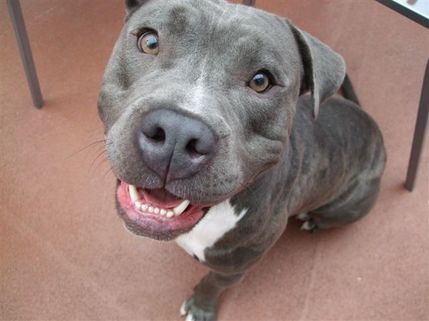 Hi! My name is Spencer, ID#A781099 Look at this face!!! Spencer is 2 years old and LOVES people and dogs. He is getting very stressed at the shelter and is not doing well there. He has until Monday June 18th to find a home.Please go meet this wonderful dog today! He is at the San Jose Animal Care Center. Ask to meet Spencer - you won't be sorry! For more information about Spencer read his page here.
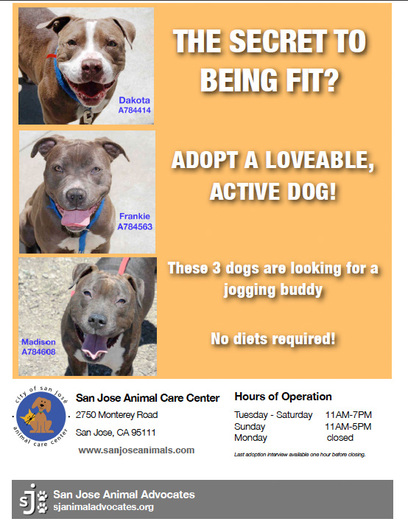 Ok - it is now officially the season to get get active and fit!
These three wonderful dogs are waiting to be adopted at the San Jose Animal Care Center and will become your own personal trainer :) Hikes, runs, long walks, beach combing, they will help you fit into that swimsuit in no time. Plus, you will receive unconditional love, snuggles, endless tail wagging AND you save a life!
Please help us spread the word about these loveable dogs! They have been waiting at the shelter too long, and the shelter, the volunteers and all of us at San Jose Animal Advocates want to find them good homes!! Click on the links below to learn more about each one of these special girls! Please go to the shelter TODAY and meet your new best friend. Dakota
Frankie
Madison
 The holiday season is a wonderful time to add a new member to your family. If you are considering adopting a shelter or rescue dog, Lisa Perrault, a certified dog trainer has some important tips for you to keep in mind. Whether this is your first family dog or one of many, there are a few things you can do to make this big transition easier for you and your pet. Patience is the first step in the transition It takes time to develop the close bonds we feel with our animals and it is common to have a “what have I done?” moment or two. Many of us underestimate how much time it takes for a new dog to understand the household rules and we forget that even our best-behaved pups didn’t start off as perfect angels. Shelter life to new lifeJust as you will need time to adjust, your dog will too. Shelter life is very different than living in a home, and many dogs find it exhausting. Do not be surprised if your new dog sleeps a lot, or is not very interested in food. Other dogs have difficulty relaxing and may be velcroed to your leg at first. Expect that your dog will need time to decompress, just like a kid returning from a summer at sleepover camp. The first weeks are the perfect time to agree on the house rules and establish a daily routine. Map out a schedule including meal times, potty breaks, exercise walks, play times, quiet time and training times. Not only will the consistency help your dog feel at home, it is the fastest way to house train a new dog. HousetrainingA few lucky owners will find their newly adopted dog is already house trained. More often however, adopted dogs were not fully house trained in a previous home or have forgotten due to shelter living. It is best to expect that your new adult dog will need a refresher course. To do this, you will need to provide a safe and comfortable confinement space for your dog. Think of the confinement space like your dog’s bedroom, it is where she can safely and comfortably hang out when unsupervised or when the world gets to be too much. A family room, a kitchen blocked off with a baby gate, a bathroom or a crate are good options. The best confinement spaces are close to where your family spends a lot of time, but not somewhere your dog can get into mischief when you are not around. Choose a space with tile or linoleum floors. Puppy-proof the room by installing child-proof locks on cabinets that contain medications or cleaning products. Survey the room from a dog’s perspective and remove anything that might be seen as a game or food including: toilet paper rolls, waste paper baskets, food on the counter and hanging hand towels. The necessities Provide your dog with a soft bed, a bowl of water and a few durable chew toys. A rubber Kong toy stuffed with tasty treats makes a wonderful distraction and will help your dog learn to love her new bedroom. At some point all dogs will need to be left home alone and this can be a challenge for a newly adopted dog. Many of us are so excited with our new pet that we spend Saturday and Sunday by their side and then leave them for hours at a time on Monday morning. Start on day one to teach your dog that her bedroom is a safe and special place to be. Stuff a Kong toy with something delicious and give it to your dog in her confinement area. When she is busy chewing, nonchalantly head to another room without saying anything to your dog. As long as your dog is quiet, return a few minutes later and ignore her as if you’ve never left. If you do this a few times a day, your dog will learn that this is her safe zone and that people come back soon. Confinement and routineA confinement space and establishing a regular routine will help prevent the mistakes that newly adopted dogs regularly make when entering new homes. Once you know your dog will not pee on carpets or chew furniture, you can leave him in a larger space in the house or with doggie door access to outside. Starting off small is also the key to introducing him to his extended network of friends and family. Instead of the dog park, meet up with a doggie friend for a neighborhood walk and save the huge “welcome home” bash for a one year adoption anniversary party. Once you get to know your dog and what he loves, you can tailor his social life to match his personality. Basic mannersThe first few weeks are also the time to get started on basic manners training. Some adult rescue dogs know a few commands while others are a clean slate and ready to learn. Teaching your dog to look at you when you say his name is always a good first step. Grab a handful of your dog’s dinner and move all around the house and yard saying his name and tossing him a treat. You may want to consider attending a family-friendly reward based training class. Even if you’ve done training before, it is a fun way to bond with your dog and stay current with modern training techniques. Remember to take pictures to share with your dog’s friends at the rescue. Everyone loves to celebrate a happy ending! Lisa Perreault is a Certified Pet Dog Trainer. She teaches classes and offers private behavior consultations through her company My Well Mannered Mutt. Lisa lives in Mountain View with her husband and two mutts.
Maddie's Fund ® has partnered with the Ad Council, The Humane Society of the United States, and the entire animal welfare community for The Shelter Pet Project, a three year public service advertising campaign designed to encourage pet lovers throughout the country to make shelters and rescue groups the first place they turn to when acquiring companion animals. Check out this public service announcement. I love it!
|













 RSS Feed
RSS Feed